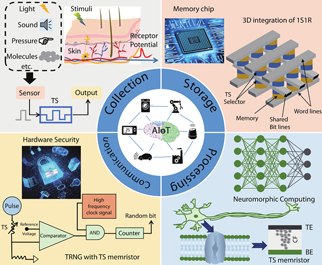
Author Affiliations
Abstract
1 Hubei Key Laboratory for Advanced Memories, School of Integrated Circuits, Huazhong University of Science and Technology, Wuhan 430074, China
2 Hubei Yangtze Memory Laboratories, Wuhan 430205, China
3 School of Microelectronics and Faculty of Physics and Electronics Science, Hubei University, Wuhan 430062, China
4 Department of Applied Physics, The Hong Kong Polytechnic University, Hong Kong, China
With rapid advancement and deep integration of artificial intelligence and the internet-of-things, artificial intelligence of things has emerged as a promising technology changing people’s daily life. Massive growth of data generated from the devices challenges the AIoT systems from information collection, storage, processing and communication. In the review, we introduce volatile threshold switching memristors, which can be roughly classified into three types: metallic conductive filament-based TS devices, amorphous chalcogenide-based ovonic threshold switching devices, and metal-insulator transition based TS devices. They play important roles in high-density storage, energy efficient computing and hardware security for AIoT systems. Firstly, a brief introduction is exhibited to describe the categories (materials and characteristics) of volatile TS devices. And then, switching mechanisms of the three types of TS devices are discussed and systematically summarized. After that, attention is focused on the applications in 3D cross-point memory technology with high storage-density, efficient neuromorphic computing, hardware security (true random number generators and physical unclonable functions), and others (steep subthreshold slope transistor, logic devices,etc.). Finally, the major challenges and future outlook of volatile threshold switching memristors are presented.
AIoT threshold switching memristor selector neuromorphic computing hardware security Journal of Semiconductors
2023, 44(5): 053102
物理不可克隆函数(PUF)作为一种可有效地应对硬件安全问题的电路结构, 在近些年得到了广泛的关注。环形振荡器(RO) PUF由于不需要完全对称的布线方式, 因此被认为是最理想的PUF结构之一。现有的RO PUF设计愈加复杂且需要“硬宏”来固定电路, 这导致PUF的移植性很差。文章利用FPGA中固有的进位逻辑资源实现RO PUF, 通过将3个进位逻辑中的11个异或门级联, 经配置实现11阶振荡环, 有效解决了可移植性问题, 避免了使用“硬宏”来固定电路。采用Xilinx Spartan-6, 对提出的结构进行实验。实验结果表明, 设计的RO PUF实现了50.65%的均匀性、48.48%的唯一性和1.56%的误码率。该设计方法具有易于实现、资源占用形式单一、无需手动布局布线等特点。
硬件安全 物理不可克隆函数 环形振荡器 进位逻辑 反相器 hardware security physical unclonable function ring oscillator carry logic inverter





